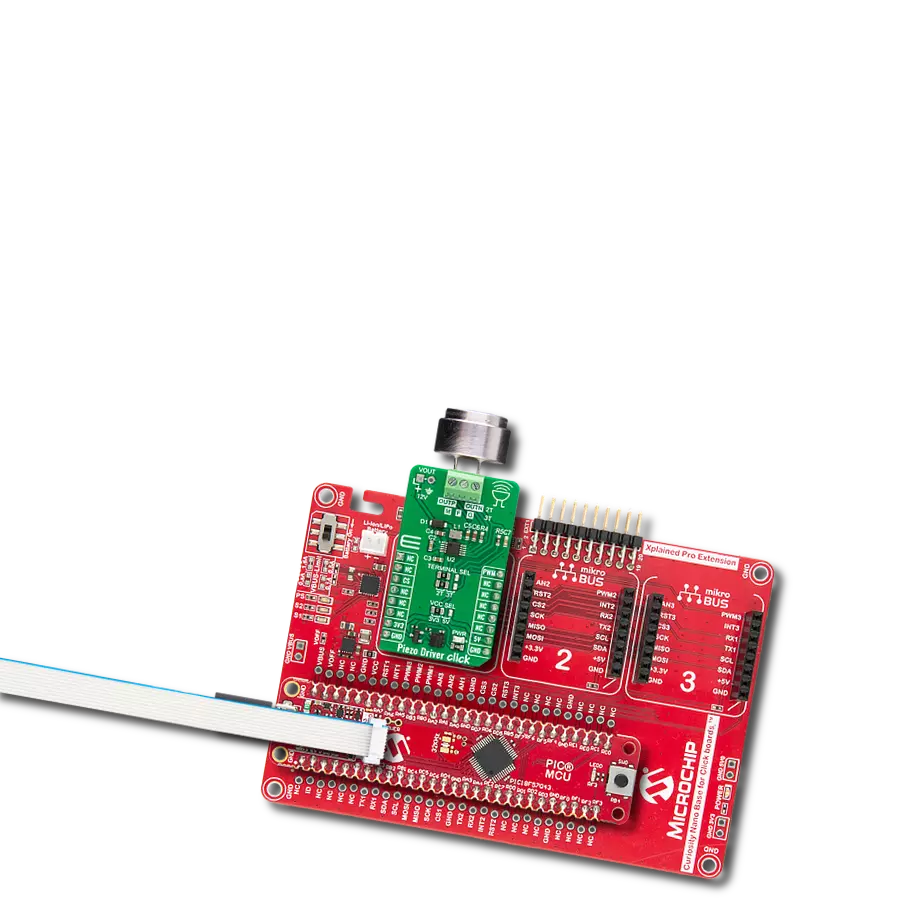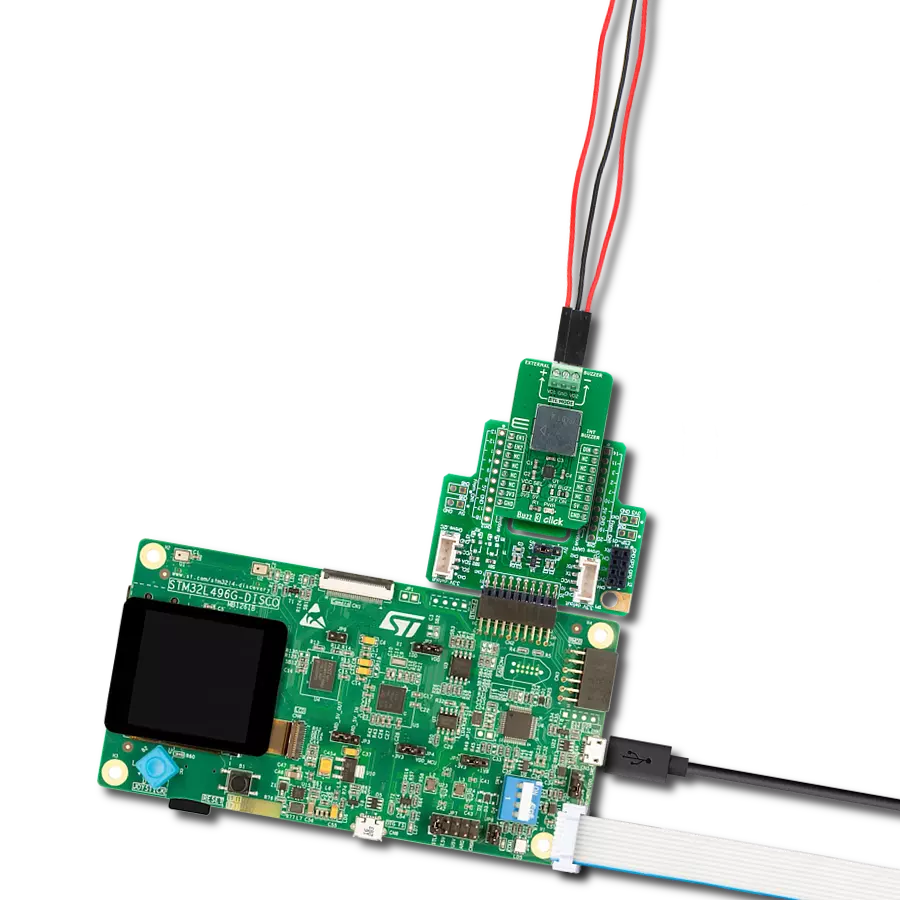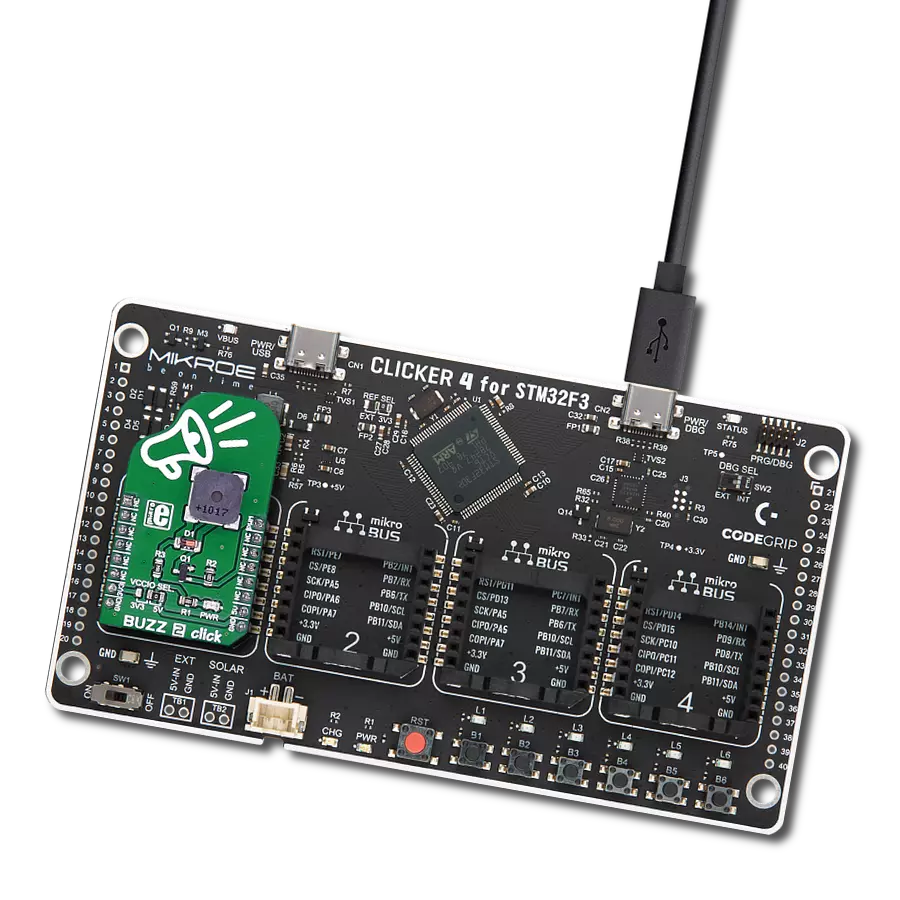Discover how our buzzer solution can revolutionize your daily life, from enhancing home security to streamlining industrial processes
A
A
Hardware Overview
How does it work?
BUZZ 2 Click is based on the CMT-8540S-SMT, a magnetic buzzer transducer from CUI Devices. The buzzer's resonant frequency is 4kHz. The click is designed to run on either a 3.3V or 5V power supply. The PWM pin on the mikroBUS™ line controls the CMT-8540S-SMT magnetic buzzer. You can create different sound patterns using
the Sound library supported in our compilers or utilize the microcontroller's internal PWM module to create the signal for the buzzer. Signal frequency determines the sound pitch, and the duty cycle determines the amplitude (sound volume). This Click board™ can operate with either 3.3V or 5V logic voltage levels selected via the
VCCIO SEL jumper. This way, both 3.3V and 5V capable MCUs can use the communication lines properly. Also, this Click board™ comes equipped with a library containing easy-to-use functions and an example code that can be used as a reference for further development.
Features overview
Development board
PIC18F57Q43 Curiosity Nano evaluation kit is a cutting-edge hardware platform designed to evaluate microcontrollers within the PIC18-Q43 family. Central to its design is the inclusion of the powerful PIC18F57Q43 microcontroller (MCU), offering advanced functionalities and robust performance. Key features of this evaluation kit include a yellow user LED and a responsive
mechanical user switch, providing seamless interaction and testing. The provision for a 32.768kHz crystal footprint ensures precision timing capabilities. With an onboard debugger boasting a green power and status LED, programming and debugging become intuitive and efficient. Further enhancing its utility is the Virtual serial port (CDC) and a debug GPIO channel (DGI
GPIO), offering extensive connectivity options. Powered via USB, this kit boasts an adjustable target voltage feature facilitated by the MIC5353 LDO regulator, ensuring stable operation with an output voltage ranging from 1.8V to 5.1V, with a maximum output current of 500mA, subject to ambient temperature and voltage constraints.
Microcontroller Overview
MCU Card / MCU

Architecture
PIC
MCU Memory (KB)
128
Silicon Vendor
Microchip
Pin count
48
RAM (Bytes)
8196
You complete me!
Accessories
Curiosity Nano Base for Click boards is a versatile hardware extension platform created to streamline the integration between Curiosity Nano kits and extension boards, tailored explicitly for the mikroBUS™-standardized Click boards and Xplained Pro extension boards. This innovative base board (shield) offers seamless connectivity and expansion possibilities, simplifying experimentation and development. Key features include USB power compatibility from the Curiosity Nano kit, alongside an alternative external power input option for enhanced flexibility. The onboard Li-Ion/LiPo charger and management circuit ensure smooth operation for battery-powered applications, simplifying usage and management. Moreover, the base incorporates a fixed 3.3V PSU dedicated to target and mikroBUS™ power rails, alongside a fixed 5.0V boost converter catering to 5V power rails of mikroBUS™ sockets, providing stable power delivery for various connected devices.
Used MCU Pins
mikroBUS™ mapper
Take a closer look
Click board™ Schematic

Step by step
Project assembly
Track your results in real time
Application Output
1. Application Output - In Debug mode, the 'Application Output' window enables real-time data monitoring, offering direct insight into execution results. Ensure proper data display by configuring the environment correctly using the provided tutorial.

2. UART Terminal - Use the UART Terminal to monitor data transmission via a USB to UART converter, allowing direct communication between the Click board™ and your development system. Configure the baud rate and other serial settings according to your project's requirements to ensure proper functionality. For step-by-step setup instructions, refer to the provided tutorial.

3. Plot Output - The Plot feature offers a powerful way to visualize real-time sensor data, enabling trend analysis, debugging, and comparison of multiple data points. To set it up correctly, follow the provided tutorial, which includes a step-by-step example of using the Plot feature to display Click board™ readings. To use the Plot feature in your code, use the function: plot(*insert_graph_name*, variable_name);. This is a general format, and it is up to the user to replace 'insert_graph_name' with the actual graph name and 'variable_name' with the parameter to be displayed.

Software Support
Library Description
This library contains API for BUZZ 2 Click driver.
Key functions:
buzz2_set_duty_cycle- BUZZ 2 sets PWM duty cyclebuzz2_play_sound- Play sound functionbuzz2_pwm_start- BUZZ 2 start PWM module
Open Source
Code example
The complete application code and a ready-to-use project are available through the NECTO Studio Package Manager for direct installation in the NECTO Studio. The application code can also be found on the MIKROE GitHub account.
/*!
* @file main.c
* @brief Buzz2 Click example
*
* # Description
* This example demonstrates the use of Buzz 2 Click boards.
*
* The demo application is composed of two sections :
*
* ## Application Init
* Initializes the driver and logger.
*
* ## Application Task
* Plays the Imperial March melody. Also logs an appropriate message on the USB UART.
*
* @note
* The minimal PWM Clock frequency required for this example is the frequency of tone C6 - 1047 Hz.
* So, in order to run this example and play all tones correctly, the user will need to decrease
* the MCU's main clock frequency in MCU Settings for the certain architectures
* in order to get the required PWM clock frequency.
*
* @author Jelena Milosavljevic
*
*/
#include "board.h"
#include "log.h"
#include "buzz2.h"
#define W 4*Q // Whole 4/4 - 4 Beats
#define H 2*Q // Half 2/4 - 2 Beats
#define Q 250 // Quarter 1/4 - 1 Beat
#define E Q/2 // Eighth 1/8 - 1/2 Beat
#define S Q/4 // Sixteenth 1/16 - 1/4 Beat
#define VOLUME 100 // goes up to 1000
static buzz2_t buzz2;
static log_t logger;
static void imperial_march( )
{
buzz2_play_sound(&buzz2, BUZZ2_NOTE_A6, VOLUME, Q );
Delay_ms ( 1 + Q );
buzz2_play_sound(&buzz2, BUZZ2_NOTE_A6, VOLUME, Q );
Delay_ms ( 1 + Q );
buzz2_play_sound(&buzz2, BUZZ2_NOTE_A6, VOLUME, Q );
Delay_ms ( 1 + Q );
buzz2_play_sound(&buzz2, BUZZ2_NOTE_F6, VOLUME, E + S );
Delay_ms ( 1 + E + S );
buzz2_play_sound(&buzz2, BUZZ2_NOTE_C7, VOLUME, S );
Delay_ms ( 1 + S );
buzz2_play_sound(&buzz2, BUZZ2_NOTE_A6, VOLUME, Q );
Delay_ms ( 1 + Q );
buzz2_play_sound(&buzz2, BUZZ2_NOTE_F6, VOLUME, E + S );
Delay_ms ( 1 + E + S );
buzz2_play_sound(&buzz2, BUZZ2_NOTE_C7, VOLUME, S );
Delay_ms ( 1 + S );
buzz2_play_sound(&buzz2, BUZZ2_NOTE_A6, VOLUME, H );
Delay_ms ( 1 + H );
buzz2_play_sound(&buzz2, BUZZ2_NOTE_E7, VOLUME, Q );
Delay_ms ( 1 + Q );
buzz2_play_sound(&buzz2, BUZZ2_NOTE_E7, VOLUME, Q );
Delay_ms ( 1 + Q );
buzz2_play_sound(&buzz2, BUZZ2_NOTE_E7, VOLUME, Q );
Delay_ms ( 1 + Q );
buzz2_play_sound(&buzz2, BUZZ2_NOTE_F7, VOLUME, E + S );
Delay_ms ( 1 + E + S );
buzz2_play_sound(&buzz2, BUZZ2_NOTE_C7, VOLUME, S );
Delay_ms ( 1 + S );
buzz2_play_sound(&buzz2, BUZZ2_NOTE_Ab6, VOLUME, Q );
Delay_ms ( 1 + Q );
buzz2_play_sound(&buzz2, BUZZ2_NOTE_F6, VOLUME, E + S );
Delay_ms ( 1 + E + S );
buzz2_play_sound(&buzz2, BUZZ2_NOTE_C7, VOLUME, S );
Delay_ms ( 1 + S );
buzz2_play_sound(&buzz2, BUZZ2_NOTE_A6, VOLUME, H );
Delay_ms ( 1 + H );
buzz2_play_sound(&buzz2, BUZZ2_NOTE_A7, VOLUME, Q );
Delay_ms ( 1 + Q );
buzz2_play_sound(&buzz2, BUZZ2_NOTE_A6, VOLUME, E + S );
Delay_ms ( 1 + E + S );
buzz2_play_sound(&buzz2, BUZZ2_NOTE_A6, VOLUME, S );
Delay_ms ( 1 + S );
buzz2_play_sound(&buzz2, BUZZ2_NOTE_A7, VOLUME, Q );
Delay_ms ( 1 + Q );
buzz2_play_sound(&buzz2, BUZZ2_NOTE_Ab7, VOLUME, E + S );
Delay_ms ( 1 + E + S );
buzz2_play_sound(&buzz2, BUZZ2_NOTE_G7, VOLUME, S );
Delay_ms ( 1 + S );
buzz2_play_sound(&buzz2, BUZZ2_NOTE_Gb7, VOLUME, S );
Delay_ms ( 1 + S );
buzz2_play_sound(&buzz2, BUZZ2_NOTE_E7, VOLUME, Q );
Delay_ms ( 1 + Q );
buzz2_play_sound(&buzz2, BUZZ2_NOTE_F7, VOLUME, E );
Delay_ms ( 1 + E );
Delay_ms ( 1 + E );
buzz2_play_sound(&buzz2, BUZZ2_NOTE_Bb6, VOLUME, E );
Delay_ms ( 1 + E );
buzz2_play_sound(&buzz2, BUZZ2_NOTE_Eb7, VOLUME, Q );
Delay_ms ( 1 + Q );
buzz2_play_sound(&buzz2, BUZZ2_NOTE_D7, VOLUME, E + S );
Delay_ms ( 1 + E + S );
buzz2_play_sound(&buzz2, BUZZ2_NOTE_Db7, VOLUME, S );
Delay_ms ( 1 + S );
buzz2_play_sound(&buzz2, BUZZ2_NOTE_C7, VOLUME, S );
Delay_ms ( 1 + S );
buzz2_play_sound(&buzz2, BUZZ2_NOTE_B6, VOLUME, S );
Delay_ms ( 1 + S );
buzz2_play_sound(&buzz2, BUZZ2_NOTE_C7, VOLUME, E );
Delay_ms ( 1 + E );
Delay_ms ( 1 + E );
buzz2_play_sound(&buzz2, BUZZ2_NOTE_F6, VOLUME, E );
Delay_ms ( 1 + E );
buzz2_play_sound(&buzz2, BUZZ2_NOTE_Ab6, VOLUME, Q );
Delay_ms ( 1 + Q );
buzz2_play_sound(&buzz2, BUZZ2_NOTE_F6, VOLUME, E + S );
Delay_ms ( 1 + E + S );
buzz2_play_sound(&buzz2, BUZZ2_NOTE_A6, VOLUME, S );
Delay_ms ( 1 + S );
buzz2_play_sound(&buzz2, BUZZ2_NOTE_C7, VOLUME, Q );
Delay_ms ( 1 + Q );
buzz2_play_sound(&buzz2, BUZZ2_NOTE_A6, VOLUME, E + S );
Delay_ms ( 1 + E + S );
buzz2_play_sound(&buzz2, BUZZ2_NOTE_C7, VOLUME, S );
Delay_ms ( 1 + S );
buzz2_play_sound(&buzz2, BUZZ2_NOTE_E7, VOLUME, H );
Delay_ms ( 1 + H );
buzz2_play_sound(&buzz2, BUZZ2_NOTE_A7, VOLUME, Q );
Delay_ms ( 1 + Q );
buzz2_play_sound(&buzz2, BUZZ2_NOTE_A6, VOLUME, E + S );
Delay_ms ( 1 + E + S );
buzz2_play_sound(&buzz2, BUZZ2_NOTE_A6, VOLUME, S );
Delay_ms ( 1 + S );
buzz2_play_sound(&buzz2, BUZZ2_NOTE_A7, VOLUME, Q );
Delay_ms ( 1 + Q );
buzz2_play_sound(&buzz2, BUZZ2_NOTE_Ab7, VOLUME, E + S );
Delay_ms ( 1 + E + S );
buzz2_play_sound(&buzz2, BUZZ2_NOTE_G7, VOLUME, S );
Delay_ms ( 1 + S );
buzz2_play_sound(&buzz2, BUZZ2_NOTE_Gb7, VOLUME, S );
Delay_ms ( 1 + S );
buzz2_play_sound(&buzz2, BUZZ2_NOTE_E7, VOLUME, S );
Delay_ms ( 1 + S );
buzz2_play_sound(&buzz2, BUZZ2_NOTE_F7, VOLUME, E );
Delay_ms ( 1 + E );
Delay_ms ( 1 + E );
buzz2_play_sound(&buzz2, BUZZ2_NOTE_Bb6, VOLUME, E );
Delay_ms ( 1 + E );
buzz2_play_sound(&buzz2, BUZZ2_NOTE_Eb7, VOLUME, Q );
Delay_ms ( 1 + Q );
buzz2_play_sound(&buzz2, BUZZ2_NOTE_D7, VOLUME, E + S );
Delay_ms ( 1 + E + S );
buzz2_play_sound(&buzz2, BUZZ2_NOTE_Db7, VOLUME, S );
Delay_ms ( 1 + S );
buzz2_play_sound(&buzz2, BUZZ2_NOTE_C7, VOLUME, S );
Delay_ms ( 1 + S );
buzz2_play_sound(&buzz2, BUZZ2_NOTE_B6, VOLUME, S );
Delay_ms ( 1 + S );
buzz2_play_sound(&buzz2, BUZZ2_NOTE_C7, VOLUME, E );
Delay_ms ( 1 + E );
Delay_ms ( 1 + E );
buzz2_play_sound(&buzz2, BUZZ2_NOTE_F6, VOLUME, E );
Delay_ms ( 1 + E );
buzz2_play_sound(&buzz2, BUZZ2_NOTE_Ab6, VOLUME, Q );
Delay_ms ( 1 + Q );
buzz2_play_sound(&buzz2, BUZZ2_NOTE_F6, VOLUME, E + S );
Delay_ms ( 1 + E + S );
buzz2_play_sound(&buzz2, BUZZ2_NOTE_C7, VOLUME, S );
Delay_ms ( 1 + S );
buzz2_play_sound(&buzz2, BUZZ2_NOTE_A6, VOLUME, Q );
Delay_ms ( 1 + Q );
buzz2_play_sound(&buzz2, BUZZ2_NOTE_F6, VOLUME, E + S );
Delay_ms ( 1 + E + S );
buzz2_play_sound(&buzz2, BUZZ2_NOTE_C7, VOLUME, S );
Delay_ms ( 1 + S );
buzz2_play_sound(&buzz2, BUZZ2_NOTE_Ab6, VOLUME, H );
Delay_ms ( 1 + H );
}
void application_init ( void ) {
log_cfg_t log_cfg; /**< Logger config object. */
buzz2_cfg_t buzz2_cfg; /**< Click config object. */
/**
* Logger initialization.
* Default baud rate: 115200
* Default log level: LOG_LEVEL_DEBUG
* @note If USB_UART_RX and USB_UART_TX
* are defined as HAL_PIN_NC, you will
* need to define them manually for log to work.
* See @b LOG_MAP_USB_UART macro definition for detailed explanation.
*/
LOG_MAP_USB_UART( log_cfg );
log_init( &logger, &log_cfg );
log_info( &logger, " Application Init " );
// Click initialization.
buzz2_cfg_setup( &buzz2_cfg );
BUZZ2_MAP_MIKROBUS( buzz2_cfg, MIKROBUS_1 );
err_t init_flag = buzz2_init( &buzz2, &buzz2_cfg );
if ( init_flag == PWM_ERROR ) {
log_error( &logger, " Application Init Error. " );
log_info( &logger, " Please, run program again... " );
for ( ; ; );
}
buzz2_set_duty_cycle ( &buzz2, 0.0 );
buzz2_pwm_start( &buzz2 );
Delay_ms ( 100 );
log_info( &logger, " Application Task " );
}
void application_task ( void )
{
log_printf( &logger, "Playing the Imperial March melody ...\r\n" );
imperial_march( );
// 10 seconds delay
Delay_ms ( 1000 );
Delay_ms ( 1000 );
Delay_ms ( 1000 );
Delay_ms ( 1000 );
Delay_ms ( 1000 );
Delay_ms ( 1000 );
Delay_ms ( 1000 );
Delay_ms ( 1000 );
Delay_ms ( 1000 );
Delay_ms ( 1000 );
}
int main ( void )
{
/* Do not remove this line or clock might not be set correctly. */
#ifdef PREINIT_SUPPORTED
preinit();
#endif
application_init( );
for ( ; ; )
{
application_task( );
}
return 0;
}
// ------------------------------------------------------------------------ END
Additional Support
Resources
Category:Speakers



































